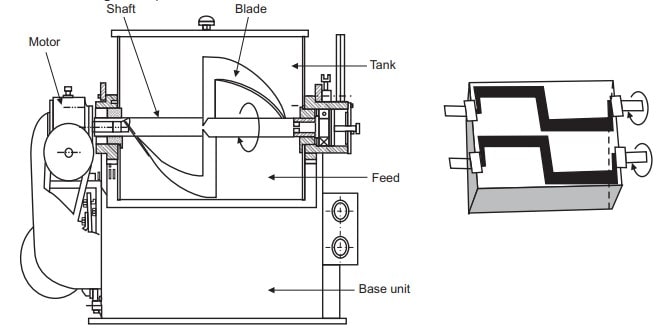The sigma blade mixer is one of the most popular mixers used for mixing and kneading high viscosity materials. It belongs to the family of double arm kneader mixers. It is a commonly used mixer for mixing high-viscosity materials.
Table of Contents
Principle of Sigma Blade Mixer
The principle involved in these mixers, wherein very viscous materials are handled, is shearing which is produced by inter-meshing sigma-shaped blades. This action promotes both lateral and transverse motion of the material. The geometry and profile of the sigma blade are designed such that the viscous mass of material is pulled, sheared, compressed, kneaded, and folded by the action of the blades against the walls of the mixer trough. The extent to which this happens depends on the action of the blades either tangential or overlapping and the speed of rotation of the blades. The helix angle of the blade can be modified depending on the required shearing.
Construction of Sigma Blade Mixer
It consists of two mixing blades fitted horizontally in each trough of the bowl. The shapes of blades resemble the Greek letter sigma (Σ) and hence are called sigma blade mixers. The clearance between the blades and the vessel walls is as low as 2 mm. The low clearances produce high shear within the material. The blades are rotated through heavy-duty drive systems consisting of a motor, gearbox, couplings, and gears. The top speed of the sigma mixer is generally limited to 60 m/min. The mixer trough has the jacket for circulation of hot or cold media to maintain the required temperature conditions within the mixer. The discharge of the material from the mixer container is either by tilting of the mixer container or from the bottom discharge valve or through an extruder/screw located in the lower portion between the two trough compartments.

Working of Sigma Blade Mixer
Powders are loaded through the top of the trough to typically 40 to 65 % of the mixer’s total volumetric capacity. The entire mixing process is carried out in a closed trough because of the dust. The blades move at a different speed using the drive system that includes the motor, gear reducer, couplings, gears, bearings, and seals. The material moves up and down and shears between the blades and the wall of the trough. The equipment is also attached to the perforated blades to break lumps and aggregates. The discharge of the material is either by tilting the mixing vessel, through the bottom discharge valve, or through a discharge screw. The homogeneous mixture is obtained within 10 to 30 min with a mixing homogeneity of up to 99%.
Advantages
(i) The sigma blade mixer leaves fewer dead spots during mixing operations.
(ii) It is ideal for mixing and kneading highly viscous mass and sticky products.
(iii) These types of mixers and their variants can handle the highly viscous materials up to as 10 million centipoises.
(iv) The provision of perforated blades makes it suitable for breaking lumps and aggregates.
(v) The losses such as loss of volatile solvent during mixing can be prevented by closing the trough chamber and maintaining a low temperature.
Disadvantages
(i) The power consumption in sigma blade mixers is very high compared to other types of mixers.
(ii) Requires more space for installation.
(iii) It requires proper blade speed adjustments.
(iv) There may be dead spots in the mixing tank.
Applications of Sigma Blade Mixer
(i) The sigma blade mixer is a commonly used mixer for high viscosity materials in preparing emulsions, syrups, and ointments.
(ii) Sigma blade mixers are used for the wet granulation process in the manufacture of tablets, capsules, and pill masses.
(iii) It is used for solid-liquid mixing as well as for solid-solid mixing.
(iv) It is the best mixer employed in the mixing components of pasty, sticky, and gritty slurries with high viscosities.
(v) Other applications of sigma blade mixer include mixing of adhesives, chemicals, chewing gum, food and confectionery products, hot-melts, inks and pigment products, soaps and detergents, sugar pastes, etc.
Double Cone Blender